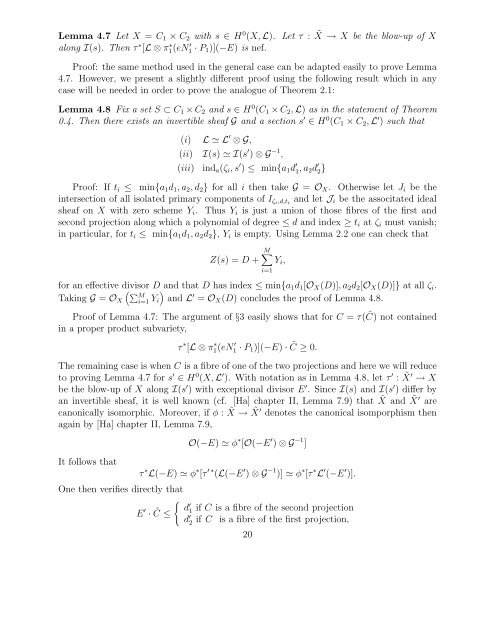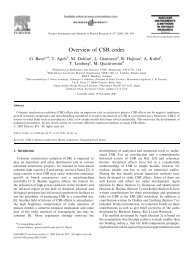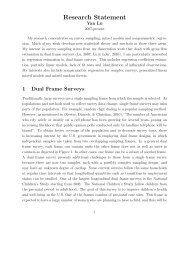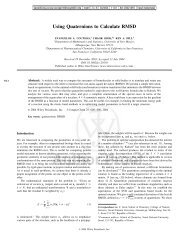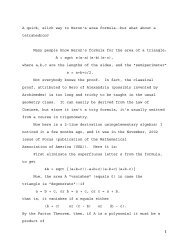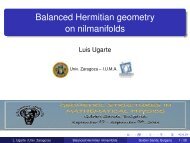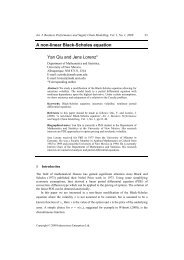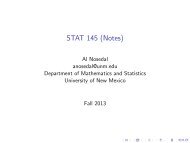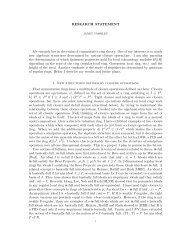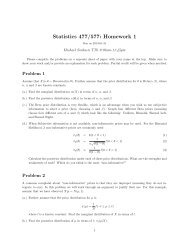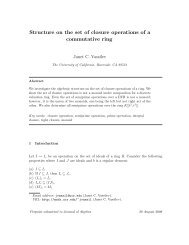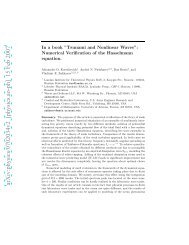Dyson's Lemma and a Theorem of Esnault and Viehweg
Dyson's Lemma and a Theorem of Esnault and Viehweg
Dyson's Lemma and a Theorem of Esnault and Viehweg
Create successful ePaper yourself
Turn your PDF publications into a flip-book with our unique Google optimized e-Paper software.
<strong>Lemma</strong> 4.7 Let X = C 1 × C 2 with s ∈ H 0 (X, L). Let τ : ˜X → X be the blow-up <strong>of</strong> Xalong I(s). Then τ ∗ [L ⊗ π ∗ 1(eN ′ 1 · P 1 )](−E) is nef.Pro<strong>of</strong>: the same method used in the general case can be adapted easily to prove <strong>Lemma</strong>4.7. However, we present a slightly different pro<strong>of</strong> using the following result which in anycase will be needed in order to prove the analogue <strong>of</strong> <strong>Theorem</strong> 2.1:<strong>Lemma</strong> 4.8 Fix a set S ⊂ C 1 ×C 2 <strong>and</strong> s ∈ H 0 (C 1 ×C 2 , L) as in the statement <strong>of</strong> <strong>Theorem</strong>0.4. Then there exists an invertible sheaf G <strong>and</strong> a section s ′ ∈ H 0 (C 1 × C 2 , L ′ ) such that(i) L ≃ L ′ ⊗ G,(ii) I(s) ≃ I(s ′ ) ⊗ G −1 ,(iii) ind a (ζ i , s ′ ) ≤ min{a 1 d ′ 1 , a 2d ′ 2 }Pro<strong>of</strong>: If t i ≤ min{a 1 d 1 , a 2 , d 2 } for all i then take G = O X . Otherwise let J i be theintersection <strong>of</strong> all isolated primary components <strong>of</strong> I ζi ,d,t i<strong>and</strong> let J i be the associtated idealsheaf on X with zero scheme Y i . Thus Y i is just a union <strong>of</strong> those fibres <strong>of</strong> the first <strong>and</strong>second projection along which a polynomial <strong>of</strong> degree ≤ d <strong>and</strong> index ≥ t i at ζ i must vanish;in particular, for t i ≤ min{a 1 d 1 , a 2 d 2 }, Y i is empty. Using <strong>Lemma</strong> 2.2 one can check thatM∑Z(s) = D + Y i ,i=1for an effective divisor D <strong>and</strong> that D has index ≤ min{a 1 d 1 [O X (D)], a 2 d 2 [O X (D)]} at all ζ i .Taking G = O X( ∑Mi=1Y i)<strong>and</strong> L ′ = O X (D) concludes the pro<strong>of</strong> <strong>of</strong> <strong>Lemma</strong> 4.8.Pro<strong>of</strong> <strong>of</strong> <strong>Lemma</strong> 4.7: The argument <strong>of</strong> §3 easily shows that for C = τ( ˜C) not containedin a proper product subvariety,τ ∗ [L ⊗ π ∗ 1 (eN ′ 1 · P 1)](−E) · ˜C ≥ 0.The remaining case is when C is a fibre <strong>of</strong> one <strong>of</strong> the two projections <strong>and</strong> here we will reduceto proving <strong>Lemma</strong> 4.7 for s ′ ∈ H 0 (X, L ′ ). With notation as in <strong>Lemma</strong> 4.8, let τ ′ : ˜X′ → Xbe the blow-up <strong>of</strong> X along I(s ′ ) with exceptional divisor E ′ . Since I(s) <strong>and</strong> I(s ′ ) differ byan invertible sheaf, it is well known (cf. [Ha] chapter II, <strong>Lemma</strong> 7.9) that ˜X <strong>and</strong> ˜X ′ arecanonically isomorphic. Moreover, if φ : ˜X → ˜X′ denotes the canonical isomporphism thenagain by [Ha] chapter II, <strong>Lemma</strong> 7.9,It follows thatO(−E) ≃ φ ∗ [O(−E ′ ) ⊗ G −1 ]τ ∗ L(−E) ≃ φ ∗ [τ ′ ∗ (L(−E ′ ) ⊗ G −1 )] ≃ φ ∗ [τ ∗ L ′ (−E ′ )].One then verifies directly that{E ′ · ˜C d′≤ 1 if C is a fibre <strong>of</strong> the second projectionif C is a fibre <strong>of</strong> the first projection,d ′ 220


